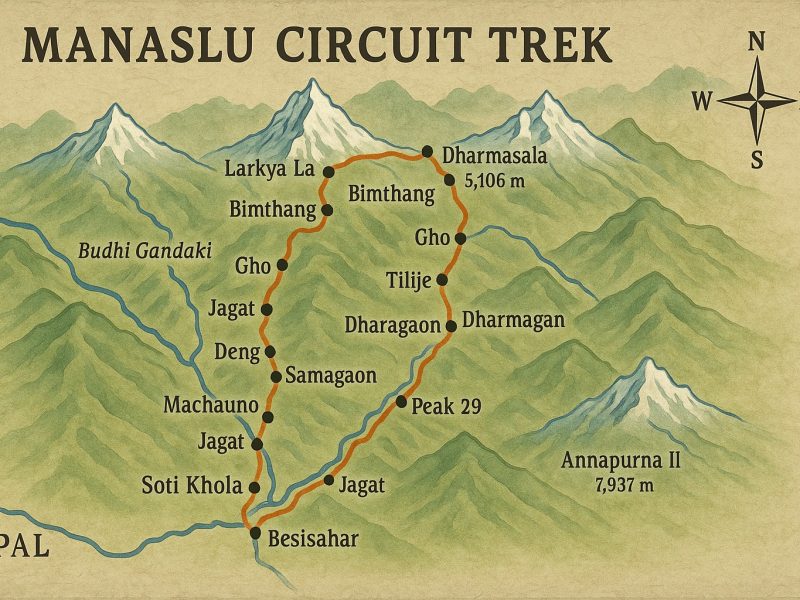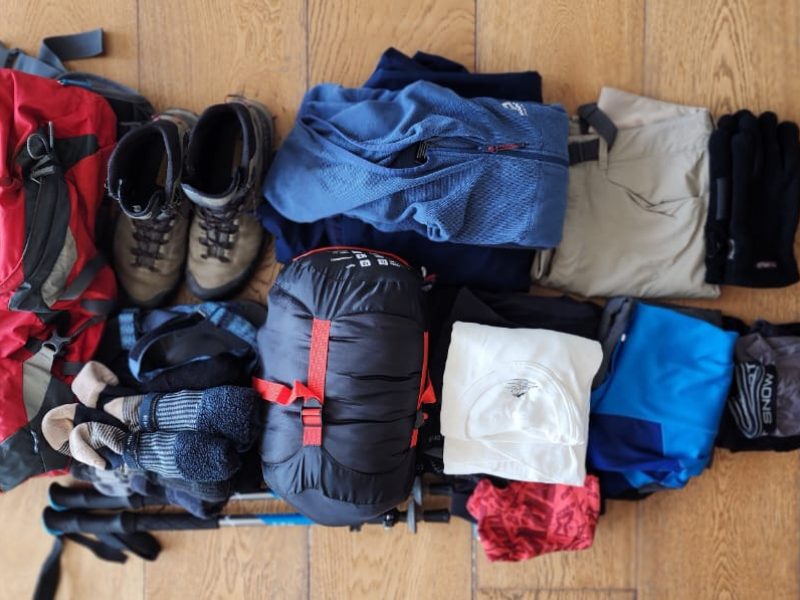
Manaslu Circuit is a classic trekking route that circles around Mt Manaslu, the eighth-highest mountain in the world. Starting from a quiet village in the foothills, the trail climbs through lush forests of rhododendron and oak, then winds past yak pastures and high-altitude lakes. As you walk the Manaslu Circuit, you follow an ancient trade route that links remote mountain communities—making every day on the trail feel like a journey back in time.
Because the Manaslu Circuit lies outside the busier trekking regions, it stays peaceful and uncrowded. You’ll often share the path with only a handful of other trekkers and local farmers, giving you a real sense of solitude. This less-crowded trek lets you enjoy the stunning Himalayan scenery—with peaks like Mt Manaslu rising above you—without the hustle and bustle found on more popular trails.
One of the biggest highlights is the view of Mt Manaslu itself. From viewpoints such as Sama Gaun and the steep ridge above Samdo, the mountain’s snow-capped summit fills the sky. Watching sunrise glow on the fluted ridges of Manaslu is an unforgettable moment—perfect for photos or simply soaking in the power of the Himalaya.
The journey also takes you over the dramatic Larkya La Pass at 5,106 m, the highest point of the trek. Crossing this snowy saddle brings a mix of excitement and reward: breath-stealing panoramas of jagged peaks on every side. Below the pass, you descend into villages where Tibetan-influenced culture thrives. In places like Bhimthang and Dharamsala, you’ll meet friendly locals, visit ancient monasteries, and taste simple teahouse meals—adding rich cultural immersion to your Manaslu Circuit adventure.
Manaslu Circuit Trek is a true off-the-beaten-path adventure, far from the crowded trails of Everest or Annapurna. You’ll walk through quiet valleys and cross high mountain passes where only a few trekkers go each day. Along the way, you’ll meet friendly people in remote villages, experience authentic Tibetan-influenced culture, and stay in simple teahouses run by locals. This unique journey gives you a real taste of Nepal’s heart and traditions, making your Manaslu Circuit trek an unforgettable cultural adventure.
Beyond culture, the landscapes on the Manaslu Circuit are simply breathtaking. You’ll hike past deep river gorges carved by the roaring Budi Gandaki River, stroll through lush alpine meadows dotted with wildflowers, and explore high glacial valleys under towering snow-capped peaks. Every turn brings dramatic views—steep cliffs, hanging glaciers, and hidden waterfalls—that feel like your own private mountain gallery. If you want a quiet, scenic trek with rich Tibetan culture and jaw-dropping scenery, the Manaslu Circuit Trek is the perfect choice.
Autumn in Nepal (September to November) is the best trekking season you can ask for. The skies stay clear, and the views of snow-topped peaks are unbeatable. Daytime temperatures feel just right—warm enough for hiking in a T-shirt, but cool enough at night to snuggle into your sleeping bag. This is peak visibility season, so every photo you take of Everest, Annapurna, or Manaslu will be crystal clear. Keywords: best trekking seasons in Nepal, autumn trekking, clear mountain views.
Spring (March to May) also shines, with colorful rhododendrons blooming all along the trails. The weather is mild and sunny, and you’ll share the paths with moderate crowds of fellow trekkers. It’s a great time for wildlife spotting too, as animals come out after winter. Keywords: spring trekking in Nepal, rhododendron bloom, mild weather.
The monsoon (June to August) and winter (December to February) bring tougher conditions but still have their fans. During the monsoon, heavy rain can cause landslides and slippery trails, so it’s best for experienced trekkers who love a challenge. Winter brings cold temperatures and snow at high altitudes, making some passes impassable. Yet hardy adventurers who crave solitude or want to test themselves in deep snow will find unique beauty and empty tea houses. Keywords: monsoon trek challenges, winter trekking Nepal, off-season hiking.
Manaslu Circuit Trek – 15 Days Itinerary
Day 1: Drive from Kathmandu to Soti Khola – Scenic countryside views.
Day 2: Trek to Machha Khola – Forested trails & riverside villages.
Day 3: Trek to Jagat – Rocky trails, hot springs, stone village.
Day 4: Trek to Deng – Beautiful forests, Gurung & Tamang villages.
Day 5: Trek to Namrung – Buddhist culture, river gorges, alpine views.
Day 6: Trek to Samagaon – Rhododendron forests, Mt. Manaslu views.
Day 7: Acclimatization – Optional hike to Manaslu Base Camp or Pungyen Gompa.
Day 8: Trek to Samdo – Remote valley, yak pastures, high-altitude village.
Day 9: Trek to Dharamsala (Larkya Phedi) – Prepare for pass crossing.
Day 10: Cross Larkya La Pass (5,160 m) to Bimtang – Big day, stunning mountain views.
Day 11: Trek to Tilije – Lush forests, warmer weather, alpine descent.
Day 12: Trek to Dharapani – Enter Annapurna Circuit region.
Day 13: Drive to Besisahar – Scenic return through hills and farms.
Day 14: Drive to Kathmandu – Back to the city and comfort.
Day 15: Departure or explore more of Kathmandu at leisure.

To trek in the Manaslu region, you need a Restricted Area Permit (RAP) because it’s a controlled area near the Tibetan border. This permit is not available for solo trekkers — you must go with a registered guide and in a group of at least two people. You can get the RAP through a government-registered trekking agency in Nepal (like Nature Heaven Treks). The cost of the permit depends on the season:
You’ll also need an MCAP (Manaslu Conservation Area Permit) and an ACAP (Annapurna Conservation Area Permit) because the route passes through both areas. The TIMS Card (Trekkers’ Information Management System) is not required for Manaslu if you already have the RAP. However, if you plan to extend your trek into the Annapurna Circuit, then a TIMS card may be needed. These permits are usually arranged by your trekking agency, but if needed, you can get them in Kathmandu or Pokhara at the Nepal Tourism Board office.
The Manaslu region is home to Tamang and Tibetan Buddhist communities, so it’s important to be respectful of local traditions. Always dress modestly — cover shoulders and legs, especially near monasteries or villages. Before taking photos of people or religious objects, ask for permission with a smile. When passing mani walls or chortens (stone prayer structures), always walk around them clockwise — it’s part of the local spiritual practice.
Be polite and use simple greetings like “Namaste” or “Tashi Delek” in Tibetan areas. Don’t touch people’s heads or point your feet at religious objects. Small gestures like removing shoes before entering homes or temples, or offering thanks in the local language, go a long way. Respecting local culture and nature not only enriches your trekking experience but also supports responsible and sustainable tourism in Nepal.
Along the Manaslu Circuit Trek, you’ll stay in local teahouses — small, family-run lodges found in every village. These teahouses usually offer basic twin-sharing rooms with wooden beds, foam mattresses, and warm blankets. Some may have attached bathrooms, but in most cases, toilets are shared and are either squat-style or simple western-style. Heating is usually available only in the dining area, where a central fire or yak dung stove keeps trekkers warm. In colder regions like Samagaon or Dharamsala, it’s a good idea to bring a warm sleeping bag for extra comfort at night.
Food on the trek is simple, nourishing, and filling. The most popular choice is dal bhat – a traditional Nepali meal of rice, lentil soup, and vegetables — and it’s “all you can eat”, perfect for hungry trekkers. Teahouses also serve noodles, soups, fried rice, pasta, Tibetan bread, and local specialties like buckwheat pancakes or tsampa porridge. As you go higher, your appetite may decrease due to the altitude, but it’s important to eat well and drink plenty of warm fluids like ginger tea, garlic soup, or hot water. Staying hydrated is key to avoiding altitude sickness, so aim to drink 3–4 liters of water daily and avoid alcohol or caffeine.

Essential Gear List for the Manaslu Circuit Trek
Your feet will do most of the work, so take special care of them. You should bring comfortable, broken-in trekking boots—never wear new boots on the trail! Also pack extra pairs of warm trekking socks to keep your feet dry and blister-free. Gaiters are a great addition too, especially if you’re trekking in the snow or rain, as they keep mud and water out of your boots. Having proper trekking footwear for the Manaslu trek will make a huge difference.
To enjoy the trek and avoid exhaustion or altitude problems, you should prepare your body in advance. Focus on cardio training like running, cycling, or swimming to build endurance. Try stair climbing or hill walking to get used to uphill climbs, and do some practice hikes with a loaded backpack to simulate real trekking days. Staying fit before the trek helps you walk longer, breathe better at high altitude, and truly enjoy the beauty of the Manaslu region.
When booking the Manaslu Circuit Trek, most trekking companies offer full package deals that include everything you need for a smooth and safe experience. A typical package usually covers a licensed guide, strong porter (to carry your bag), all meals and accommodation during the trek (teahouses), Manaslu and Annapurna permits, restricted area permits, and transportation (jeep or bus) from Kathmandu to Soti Khola and back from Dharapani. Having a professional guide and porter is not only safer but also makes your journey more enjoyable — they handle logistics, help with the local language, and share amazing insights about the mountains, villages, and culture.
In terms of cost, prices can vary based on the service level. A budget package with basic teahouses and limited services may cost around $1100–$1,300. A mid-range trek with better lodges, experienced guides, and better food options can be around $1,500–$1,700. If you’re looking for more comfort — with private rooms, hot showers, and customized services — a comfort package might range from $1,900 to $2,100+. It’s best to book early to enjoy discounts and secure your group departure dates. Many companies also allow custom itineraries, so you can add extra days or side trips. For the best value and support, always book with a trusted local trekking agency in Nepal.

1. Take Altitude Seriously
When trekking in high altitudes like the Manaslu Circuit, your body needs time to adjust. A simple rule is to “climb high, sleep low” — this means you can hike to a higher elevation during the day but come down to sleep at a lower altitude. Always take acclimatization rest days, especially in places like Samagaon. Listen to your body. If you feel symptoms like headache, nausea, or dizziness, don’t ignore it — these could be signs of altitude sickness. If it gets worse, the best and safest solution is to descend right away.
2. Stay Safe and Be Prepared
Always carry comprehensive travel insurance that covers emergency helicopter evacuation in case of serious illness or injury. Mobile network and internet may not work in high regions, so inform your guide and family about your plans ahead of time. Nature Heaven Treks and Expedition ensures every trek has an experienced guide, trained to spot altitude sickness and manage emergencies. With their local knowledge and support, your trek becomes safer, more enjoyable, and stress-free.
📞 need help or have questions?
Contact Nature Heaven Treks and Expedition:
WhatsApp: +977-9851218358
Website: https://natureheaventrek.com/st_tours/manaslu-circuit-treks/
@Copyright 2025 Nature Heaven Treks and Expedition, Kathmandu, Nepal. All Rights Reserved.
Chat with Us